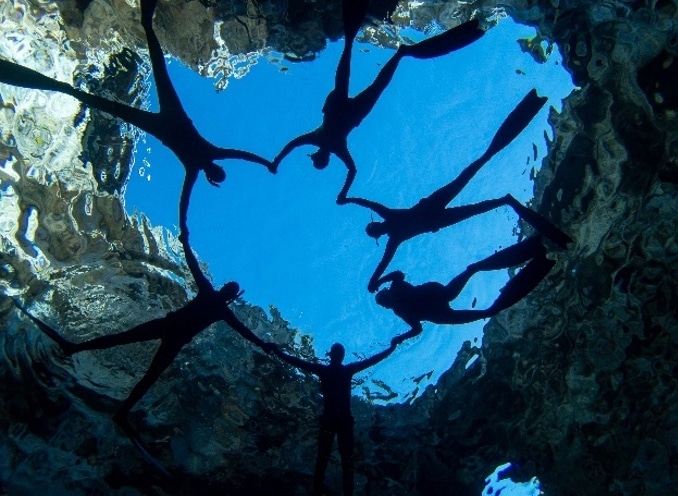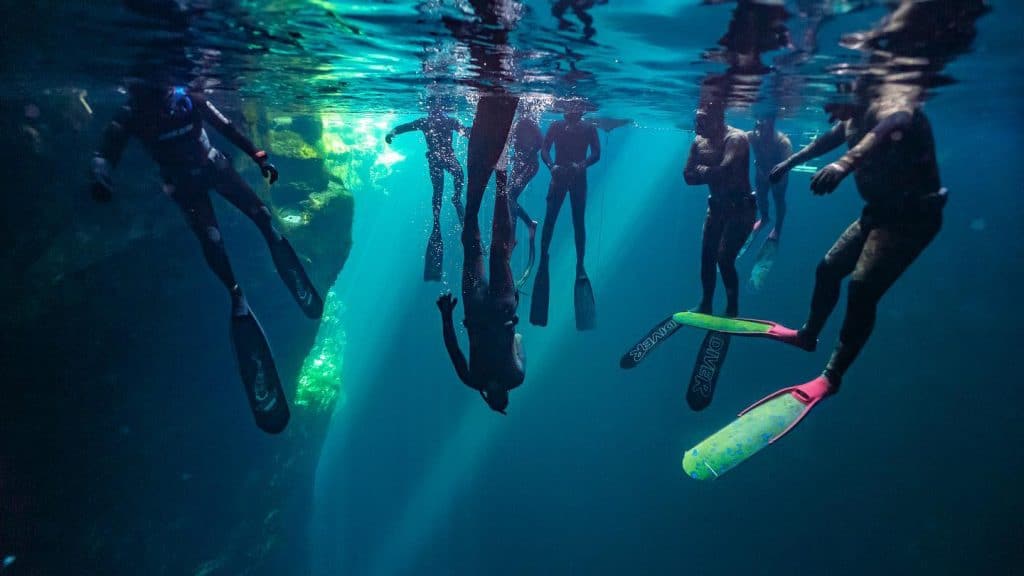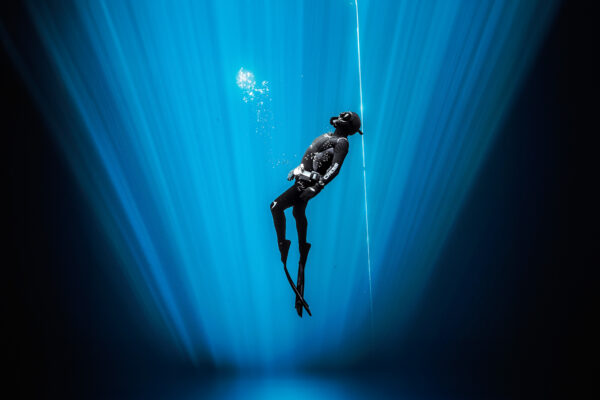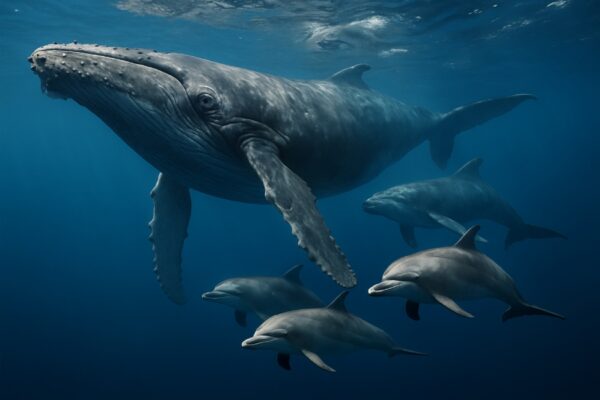History of Breath Holding and Freediving

Freediving (free-diving, free diving, breath-hold diving, or skin diving) is a form of underwater diving that relies on breath-holding until resurfacing rather than the use of breathing apparatus such as scuba gear.
Besides the limits of breath-hold, immersion in water and exposure to high ambient pressure also have physiological effects that limit the depths and duration possible in freediving.
Examples of freediving activities are traditional fishing techniques, competitive and non-competitive freediving, competitive and non-competitive spearfishing and freediving photography, synchronised swimming, underwater football, underwater rugby, underwater hockey, underwater target shooting, mermaiding and snorkeling. There are also a range of “competitive apnea” disciplines; in which competitors attempt to attain great depths, times, or distances on a single breath.
Historically, the term free diving was also used to refer to scuba diving, due to the freedom of movement compared with surface supplied diving.
HISTORY OF FREEDIVING
In ancient times freediving without the aid of mechanical devices was the only possibility, with the exception of the occasional use of reeds and leather breathing bladders. The divers faced the same problems as divers today, such as decompression sickness and blacking out during a breath hold. Freediving was practiced in ancient cultures to gather food, harvest resources such as sponge and pearl, reclaim sunken valuables, and to help aid military campaigns.
In Ancient Greece, both Plato and Homer mention the sponge as being used for bathing. The island of Kalymnos was a main centre of diving for sponges. By using weights (skandalopetra) of as much as 15 kilograms (33 lb) to speed the descent, breath-holding divers would descend to depths up to 30 metres (98 ft) to collect sponges. Harvesting of red coral was also done by divers.
The Mediterranean had large amounts of maritime trade. As a result of shipwrecks, particularly in the fierce winter storms, divers were often hired to salvage whatever they could from the seabed. Divers would swim down to the wreck and choose the most valuable pieces to salvage.
Divers were also used in warfare. Defenses against sea vessels were often created, such as underwater barricades, and hence divers were often used to scout out the seabed when ships were approaching an enemy harbor. If barricades were found, it was divers who were used to disassemble them, if possible.[7] During the Peloponnesian War, divers were used to get past enemy blockades to relay messages as well as supplies to allies or troops that were cut off, and in 332 BC, during the Siege of Tyre, the city used divers to cut the anchor cables of Alexander’s attacking ships.
In Japan, ama divers began to collect pearls about 2,000 years ago. For thousands of years, most seawater pearls were retrieved by divers working in the Indian Ocean, in areas such as the Persian Gulf, the Red Sea, and in the Gulf of Mannar (between Sri Lanka and India). A fragment of Isidore of Charax’s Parthian itinerary was preserved in Athenaeus’s 3rd-century Sophists at Dinner, recording freediving for pearls around an island in the Persian Gulf.
Pearl divers near the Philippines were also successful at harvesting large pearls, especially in the Sulu Archipelago. At times, the largest pearls belonged by law to the sultan, and selling them could result in the death penalty for the seller. Nonetheless, many pearls made it out of the archipelago by stealth, ending up in the possession of the wealthiest families in Europe. Pearling was popular in Qatar, Bahrain, Japan, and India. The Gulf of Mexico was also known for pearling. Native Americans harvested freshwater pearls from lakes and rivers like the Ohio, Tennessee, and Mississippi, while others dived for marine pearls from the Caribbean and waters along the coasts of Central and South America.
In 1940, Dottie Frazier pioneered freediving for women in the United States and also began teaching classes. It was also during this time that she began to design and sell rubber suits for Navy UDT divers.
Recreational hunting and gathering
Spearfishing
Spearfishing is an ancient method of fishing that has been used throughout the world for millennia. Early civilizations were familiar with the custom of spearing fish from rivers and streams using sharpened sticks.
Today modern spearfishing makes use of elastic powered spearguns and slings, or compressed gas pneumatic powered spearguns, to strike the hunted fish. Specialised techniques and equipment have been developed for various types of aquatic environments and target fish. Spearfishing may be done using free-diving, snorkelling, or scuba diving techniques. Spearfishing while using scuba equipment is illegal in some countries. The use of mechanically powered spearguns is also outlawed in some countries and jurisdictions. Spearfishing is highly selective, normally uses no bait and has limited by-catch.
Collection of shellfish
Breathing techniques, relaxation and inspiration
Beside all the underwater activities, there is a trend in using the sea and nature as a medium and source of inspiration for rediscover of mindfulness.[16] Non-competitive breathing techniques and relaxation before the dive and visualization under water are practiced. Mermaid diving also focuses on the beauty under water.
Competitive breath-hold watersports
Aquathlon
Aquathlon (also known as underwater wrestling) is an underwater sport where two competitors wearing masks and fins wrestle underwater in an attempt to remove a ribbon from each other’s ankle band in order to win the bout. The “combat” takes place in a 5-metre (16 ft) square ring within a swimming pool, and is made up of three 30-second rounds, with a fourth round played in the event of a tie. The sport originated during the 1980s in the former USSR (now Russia) and was first played at international level in 1993. It was recognised by the Confédération Mondiale des Activités Subaquatiques (CMAS) in 2008.
Competitive spearfishing
Competitive spearfishing is defined by the world governing body CMAS as “the hunting and capture of fish underwater without the aid of artificial breathing devices, using gear that depends entirely on the physical strength of the competitor.” They publish a set of competition rules that are used by affiliated organisations.
Synchronised swimming
Synchronized swimming is a hybrid form of swimming, dance, and gymnastics, consisting of swimmers (either solos, duets, trios, combos, or teams) performing a synchronized routine of elaborate moves in the water, accompanied by music. Synchronized swimming demands advanced water skills, and requires great strength, endurance, flexibility, grace, artistry and precise timing, as well as exceptional breath control when upside down underwater. During lifts swimmers are not allowed to touch the bottom.
Traditionally it was a women’s sport, but following the addition of a new mixed-pair event, FINA World Aquatics competitions are open to men since the 16th 2015 championships in Kazan, and the other international and national competitions allow male competitors in every event. However, men are currently still barred from competing in the Olympics. Both USA Synchro and Synchro Canada allow men to compete with women. Most European countries also allow men to compete, and France even allows male only podiums, according to the number of participants. In the past decade, more men are becoming involved in the sport and a global biannual competition called Men’s Cup has been steadily growing.
Swimmers perform two routines for the judges, one technical and one free, as well as age group routines and figures. Synchronized swimming is both an individual and team sport. Swimmers compete individually during figures, and then as a team during the routine. Figures are made up of a combination of skills and positions that often require control, strength, and flexibility. Swimmers are ranked individually for this part of the competition. The routine involves teamwork and synchronization. It is choreographed to music and often has a theme. Synchronized swimming is governed internationally by FINA (Fédération Internationale de Natation).
Underwater hockey
Underwater Hockey, (also called Octopush (mainly in the United Kingdom)) is a globally played limited-contact sport in which two teams compete to manoeuvre a puck across the bottom of a swimming pool into the opposing team’s goal by propelling it with a pusher. It originated in England in 1954 when Alan Blake, the founder of the newly formed Southsea Sub-Aqua Club, invented the game he called Octopush as a means of keeping the club’s members interested and active over the cold winter months when open-water diving lost its appeal.[24] Underwater Hockey is now played worldwide, with the Confédération Mondiale des Activités Subaquatiques, abbreviated CMAS, as the world governing body. The first Underwater Hockey World Championship was held in Canada in 1980 after a false start in 1979 brought about by international politics and apartheid.
Underwater football
Underwater football is a two-team underwater sport that shares common elements with underwater hockey and underwater rugby. As with both of those games, it is played in a swimming pool with snorkeling equipment (mask, snorkel, and fins). The goal of the game is to manoeuvre (by carrying and passing) a slightly negatively buoyant ball from one side of a pool to the other by players who are completely submerged underwater. Scoring is achieved by placing the ball (under control) in the gutter on the side of the pool. Variations include using a toy rubber torpedo as the ball, and weighing down buckets to rest on the bottom and serve as goals.
It is played in the Canadian provinces of Alberta, Manitoba, Newfoundland and Labrador, and Saskatchewan.
Underwater rugby
Underwater rugby is an underwater team sport. During a match two teams try to score a negatively buoyant ball (filled with saltwater) into the opponents’ goal at the bottom of a swimming pool. It originated from within the physical fitness training regime existing in German diving clubs during the early 1960s and has little in common with rugby football except for the name. It was recognised by the Confédération Mondiale des Activités Subaquatiques (CMAS) in 1978 and was first played as a world championship in 1980.
Underwater target shooting
Underwater target shooting is an underwater sport that tests a competitors’ ability to accurately use a speargun via a set of individual and team events conducted in a swimming pool using free diving or apnea technique. The sport was developed in France during the early 1980s and is currently practised mainly in Europe. It is known as Tir sur cible subaquatique in French and as Tiro al Blanco Subacuático in Spanish.
Competitive Freediving:
Competitive freediving is currently governed by two world associations: AIDA International (International Association for Development of Apnea) and CMAS (Confédération Mondiale des Activités Subaquatiques – World Underwater Federation). Historically, there were two more organisations that regulated freediving records and activities – IAFD (International Association of Freedivers) and FREE (Freediving Regulations and Education Entity). Each organization has its own rules on recognizing a record attempt which can be found on the organization’s website. Alongside competitive disciplines there are record disciplines – disciplines that are not held in competitions, that are just for setting world records. There is a third organization which in addition to AIDA and CMAS preside over those record disciplines and that is Guinness.
Almost all types of competitive freediving have in common that it is an individual sport based on the best individual achievement. Exceptions to this rule are the bi-annual World Championship for Teams held by AIDA, where the combined score of the team members makes up the team’s total points and Skandalopetra diving competitions held by CMAS, the only truly ‘team’ event in freediving – for which teams are formed by two athletes: one acting as an apneista (Voutichtis; diver) and the other acting as an assistant (Kolaouzeris; person who “extracts”).
Disciplines
There are currently eleven recognized disciplines defined by AIDA and CMAS, and a dozen more that are only practiced locally. All disciplines can be practiced by both men and women and only CMAS currently separates records in fresh water from those at sea. The disciplines of AIDA can be done both in competition and as a record attempt, with the exception of Variable Weight and No limits, which are both solely for record attempts. For all AIDA depth disciplines, the depth the athlete will attempt is announced before the dive; this is accepted practice for both competition and record attempts.
CWT- Constant Weight Apnea- Measured by Depth
CWT BF, CWTB-Constant weight apnea with bifins- Measured by Depth
CNF- Constant weight apnea without fins- Measured by Depth
DNF- Dynamic apnea without fins- Measured by horizontal distance
DYN- Dynamic apnea with fins- Measured by horizonal distance
DYN BF, DYNB- Dynamic apnea with Bifins- Measured by horizontal distance
FIM- Free immersion apnea- Measured by Depth
JB- Jump Blue- Measured by horizontal distance
NLT- No-limits Apnea – Measured by Depth
Skandalopetra- Measured by Depth & Min Time
STA- Static Apnea Measured by Max Time
STA O2- Static Apnea with pure Oxygen Measured by Max Time
S&E Apena- Speed-Endurance Apnea Measure by Min Time
VNF- Variable weight apnea without fins Measured by Depth
VWT- Variable weight apnea Measured by Depth
Recreational Freediving:
Freediving as a recreational activity is widely practiced and differs significantly from scuba diving. Although there are potential risks to all freediving, it can be safely practiced using a wide range of skill levels from the average snorkeler to the professional freediver. Compared to scuba diving, freediving offers:
- Freedom from cumbersome equipment and short preparation times.
- Low cost.
- It is quiet and does not disturb fish, the noise of breathing and bubbles can be quite loud on open circuit scuba though rebreathers are much quieter.
- Mobility and speed, but for a much more limited period.
- No decompression time for deep dives, although it is possible to get decompression sickness from repetitive deep free-diving with short surface intervals.
- The lack of exhaled air bubbles on ascent gives greater visibility on ascent.
- Accessibility, if the site can be walked to it can, potentially, be dived.
- Appropriately skilled and fit freedivers can go as deep, or deeper than, recreational scuba divers, the depth being limited only by the willingness to accept the risks; scuba diving is restricted by the level of certification.
Because of this, recreational freediving is currently the fastest growing water sport in the world.



